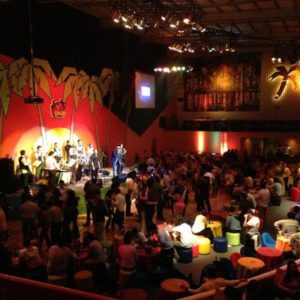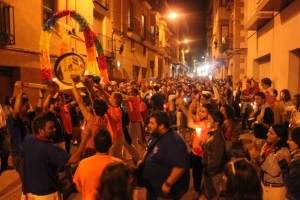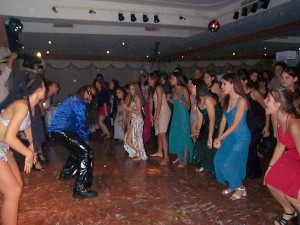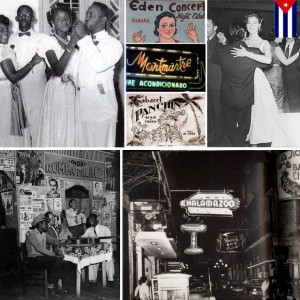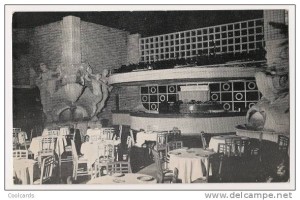SOLO EN LA HABANA EN LOS AÑOS 50s HABÍA MÁS DE 100 CENTROS DE ENTRETENIMIENTO. (ALGUNOS NOMBRES).
No hay duda ninguna que nuestro país ha sido productor de muchos ritmos bailables, lo que es natural en una nación que podría considerarse la más bailadora del mundo. Pero La Habana es con seguridad donde había más lugares donde pasar un buen rato bailando pues ya contaba en la década de los años 50s, con una gran cantidad de los centros del país donde se ofrecían bailes y diversión diariamente.
Solo en La Habana habia más de 100 Salas donde se podía bailar…
No solo se bailaba solamente en la parte vieja, el Cerro, Jesús del Monte, Vedado, la Víbora y otros barrios… sino también en Marianao, Rancho Boyeros, Regla o Guanabacoa. Solo en el Centro, o en La Habana Vieja o sus alrededores existían muchos lugares que servían de entretenimiento y muy especialmente donde se acudía a bailar:
Existían grandes asociaciones mutualistas españolas que tenían espaciosos salones y ofrecían bailes para socios e invitados como: el “Centro Asturiano”, el “Centro Gallego”, la “Artística Gallega”, la “Sociedad Curro-Enríquez” en Santo Suárez o el “Casino Español” y también todos los club sociales donde se realizaban grandes fiestas, privadas a la gran mayoría, pero esto no lo era todo.
Recordemos algunos nombres:
“Los Yesitas”, próximo a Carlos III, la “Unión Fraternal” en la Calle Revillagigedo y la de los altos del Teatro Nacional en el Paseo del Prado, la “Sociedad Unión Club” en Neptuno y Zulueta, “La Taberna San Román” en San Pedro y Oficio, por la Avenida del Puerto, el “Salón Atenas”, en Prado y Neptuno, de donde sale el famoso número de “La Engañadora” de Enrique Jorrín, “Hotel San Luis”, en Belascoaín #73 y Lagunas y las “Marquesina del Hotel Saratoga”, Paseo del Prado #603 y Dragones.
El número de club nocturnos era impresionante:
El “Palermo Club” en Amistad esquina a San Miguel (siempre con orquesta para bailar), “National Nigth Club” San Rafael y Prado, con dos shows diarios y dos orquestas, “Las Vegas” en Infanta, casi esquina a Humbolt. “Tony’s Club”, en el corazón de La Habana, detrás del Capitolio, “Bar-Club Prado 260” en Prado #260, ”Río Cristal Club” en el Km. 8 y medio de la Carretera de Rancho Boyeros Reloj Club” en la Avenida Rancho Boyeros Km. 6 y medio, “Mambo’s Club” en la Carretera de Rancho Boyeros Km. 3, el “Alí Bar” en la Avenida de Dolores y Lucero, el “Bambú Club” en la Avenida Rancho Boyeros Km. 5½, con dos shows por noche (donde bailó Tongolele), “Night Club Mulgoba” en el reparto del mismo nombre en la Avenida Rancho Boyeros, el “Night and Day” en la Avenida de Rancho Boyeros , “Sierra Nigth Club” Concha entre Cristina y Vía Blanca, dos shows diarios y dos orquestas, “Alloy Nigth Club” en Fábrica #7 Luyanó, “Morocco Club”, Paseo del Prado #402, “Intermezzo Bar” Refugio #111, “Johnny’s Bar-Club” Virtudes #58, “Pan American Bar-Club” Ayestarán #235 y el “Zombie Club”, por Zulueta, del que ya comentamos en una publicación.
En cuanto a cabaret podemos citar:
Cabaret “Sans Soucí” en Arroyo Arena Km.15, con dos orquestas cada noche y dos producciones internacionales, “Hotel Sevilla en Prado #255 y Trocadero, Cabaret “Los Troncos” Galiano #115 entre Animas y Trocadero, Cabaret “Topeka” en la Ave. de Rancho Boyeros, Cabaret “La Campana” en la Calzada de Infanta y San Martín y el Cabaret Tokio en San Lázaro y Blanco y Las Vegas, en Infanta, casi esquina a Humboldt.
Estos son los principales lugares donde se solía bailar en La Habana, ya sea la vieja, o en el centro y sus alrededores, pero aún faltan los locales de Marianao, Miramar y Vedado:
MIRAMAR:
Balneario “Casino Deportivo” en 1ra. #608, el “Club ESSO” también en 1ra, el “Club Comodoro” en 1ra. #8402, esq. 84, Hotel “Copacabana” en 1ra. #4404 y 46, “Boulevard Room” en 1ra. y 54, “Saigón Club, “Johnny’s Dream Club” en La Puntilla. Y también ofrecían bailes los diferentes clubs privados de la zona.
MARIANAO:
Los famosos y populares “Jardines de la Tropical” en el Río Almendares, “Casino de La Lisa” en la Avenida 51 #15821, el “Casino Rivolí” en la Avenida 27 #2604, “Tropicana” en la calle 72 #4504, esquina Línea del Ferrocarril, con dos salones, el “Edén Concet” “Un Paraíso Bajo las Estrellas” y el espectacular salón “Arcos de Cristal”, (“Joya de América”, considerado el Night Club más bello del mundo)., “Niche Club”, la “Taberna de Pedro”, el Cabaret “Rhumba Palace”, “Cabaret Panchin” en 5ta. Avenida #11616, “Cabaret Pennsylvania” con dos shows cada noche, en 5ta. Avenida #11801, Cabaret Mi Bohío 5ta Ave. # 11815, el “Biltmore”, en Jaimanitas, “Selva Club”en Pogolotti, donde único se podía bailar con Arsenio o Felix Chapottin, la viva expresión de la música criolla,sin menospreciar al Conjunto Casino, su favorito.
Aún quedan otros: el “Choricera Club”, un centro rústico con mesas de madera sin pintar y piso de tierra, del famoso El Chori, que ofrecía unos espectáculos con tambores batá que atraía a los turistas extranjeros, como el actor norteamericano Marlon Brando, el “Barrilito Club”, el Flotante Club, en 5ta Ave. #1160 y el “Quibú” que estaba situado detrás de la Universidad de Villanueva, cerca de la playa de Marianao, junto al arroyo del mismo nombre, y el “Buena Vista Social Club” en el barrio de Buenavista 31 Núm. 4610 entre las calles 46 y 48 Marianao.
VEDADO:
El “Club Sherezada” en el Edificio del Focsa calle 17 y M, el “Rocco Club” en 17 y O, de Roberto Pertierra, “La Red” de 19 y L, “El Gato Tuerto” de 19 y O, “La Zorra y el Cuervo” en 23 y O, “Super Club La Rue” en la calle 19 #324 esq. H, “Cabaret Parisien” y el “Arboleda Room” del Hotel nacional, “Hotel Vedado” en O #244 entre 23 y 25, “Cabaret Copa Room” del Hotel Habana Riviera y los cabarets del Hotel Capri, Hotel Havana Hilton (salón “Caribe” y en su bar “Seven Eleventh”), “Bar-Club Cortijo” del Hotel Flamingo, el “Willie’s Club”en 21 y N, “Atelier”, por 17 Y 6, “Johnnie’s 88” en O #208 entre 23 y 25, “Montmartre Night Club” en P y 23, “Embassy” en 23 y 26, “Maxim’s Club” en 3ra. y la 10, “Club 21” en la calle 21 y 22, “Nightclub Sayonara”, Club El Johnny en la Calle A y 3ra, “Edén Club” en 23 y O, “Eloy Club, en Línea, entre I y H, “Bar-Club Turf”, en Calzada y F, aunque la publicidad aclaraba “ambiente refinado” no dejaba de ser de los más oscuros.
He tratado en estos listados sólo tener en cuenta los lugares en que se bailaba. Si por casualidad algún lector recuerda haber asistido a uno de estos sitios y que no vio baile, eso no quiere decir que nunca se bailó. A finales de los 50, La Habana tenía abiertas más de 100 Salas donde se podía bailar. La Habana, desde la década de 1920 hasta la del 50, siempre tuvo una gran cantidad de bailadores que demandaban lugares donde se pudiera bailar a su gusto. Después de conocer este listado creo que no queden dudas de que era, la capital de Cuba, la ciudad más bailadora del mundo.
IN HAVANA BY THE 50s THERE WERE MORE THAN 100 ENTERTAINMENT PLACES. (SOME NAMES).
There is no doubt that our country has been the producer of many dance rhythms, which is natural in a nation that could be considered where there are posible the most dancers in the world. But Havana is certainly where there were more places to have a good time dancing in the decade of the 50s, with a large number of centers in the country where dances and fun were offered daily.
Only in Havana had more than 100 rooms where you could dance …
Not only is danced only in the old part, Cerro Jesus del Monte, Vedado, the Viper and other neighborhoods … but in Marianao, Cattle Ranch, Rule or Guanabacoa. Only in the center, or Havana Vieja or around there were many places that served entertainment and especially where they went to dance:
There were large Spanish mutual associations that had offered spacious lounges and dance to members and guests as the “Asturian Center”, the “Centro Gallego” the “Artistic Gallega”, the “Company Curro-Enriquez” in Santo Suarez or “Casino Spanish “and all social club where large parties, private to the vast majority were made but this was not all.
Let’s remember some names:
“The Yesitas” next to Carlos III, the “Fraternal Union” on Revillagigedo Street and the highest in the National Theater in the Paseo del Prado, the “Company Union Club” in Neptune and Zulueta, “La Taberna San Román” San Pedro and Occupation, by the Avenida del Puerto, the “Athens Lounge” at Prado and Neptuno, from where the famous number “The Engañadora” Henry Jorrín, “Hotel San Luis” in Belascoaín # 73 and Ponds and “Marquee Hotel Saratoga” Paseo del Prado # 603 and Dragons.
The number of nightclubs was impressive:
The “Palermo Club” in San Miguel Friendship corner (always with orchestra for dancing), “National Nightclub” San Rafael and Prado, with two daily shows and two orchestras, “Las Vegas” in Infanta, near the corner of Humboldt. “Tony’s Club”, in the heart of Havana, behind the Capitol, “Bar-Club Prado 260” in Prado # 260, “Crystal River Club” at Km. 8 and middle of the road Cattle Ranch Clock Club “in Avenida Rancho Boyeros Km. 6 and a half, “Mambo’s Club” on the road to Rancho Boyeros Km. 3, the “Ali Bar” on Avenida de Dolores and Lucero, the “Bamboo Club” on Avenida Rancho Boyeros Km. 5½ with two shows per night (where Tongolele danced), “Night Club Mulgoba” in sharing the same name in the Avenida Rancho Boyeros, the “Night and Day” on Avenida de Rancho Boyeros, “Sierra Nightclub” Concha between Cristina and Vía Blanca, two daily shows and two orchestras, “Alloy NightClub” Factory No. 7 Luyanó, “Morocco Club” Paseo del Prado # 402, “Intermezzo Bar” Refugio # 111, “Johnny’s Bar-Club” Virtues # 58 “Pan American Bar-Club” Ayestarán # 235 and “Zombie Club” for Zulueta, which we discussed in a publication.
As a cabaret we can mention:
Cabaret “Sans Souci” in Arroyo Arena Km.15, with two bands every night and two international productions, “Hotel Sevilla in Prado # 255 and Trocadero, Cabaret” Trunks “Galiano # 115 between Animas and Trocadero, Cabaret” Topeka “in Cattle Ranch Ave., Cabaret “La Campana” in Calzada de Infanta and San Martin and the Cabaret Tokyo in San Lazaro and White and Las Vegas, in Infanta, near the corner of Humboldt.
These are the main places where you used to dance in Havana, either the old or in the center and surroundings, but still missing the premises of Marianao, Vedado and Miramar:
MIRAMAR:
Spa “Casino Deportivo” in 1. # 608, the “Club ESSO” also in 1, the “Club Commodore” in 1. # 8402, esq. 84, Hotel “Copacabana” in 1. # 4404 and 46, “Boulevard Room” at 1st. and 54, “Saigon Club,” Johnny’s Dream Club “in La Puntilla. And dances offered different private clubs in the area.
MARIANAO:
The famous and popular “Tropical Gardens” in the Almendares River, “Casino de La Lisa” on Avenida 51 # 15821, the “Casino Rivoli” on 27th Avenue # 2604, “Tropicana” on 72nd Street # 4504, Line Railroad corner, two rooms, the “Eden Concert” “A Paradise Under the Stars” and the spectacular living “Arcos de Cristal” (“Jewel of America”, considered the world’s most beautiful Night Club). ” Niche Club “, the” Taberna de Pedro “Cabaret” Rhumba Palace “,” Cabaret Panchín “in the 5th. Avenida # 11616, “Cabaret Pennsylvania” with two shows each night in the 5th. Avenida # 11801, Cabaret My Bohío 5th Ave. # 11815, the “Biltmore” in Jaimanita, “Jungle Club” in Pogolotti where one could dance with Arsenio or Felix Chapottin, the living expression of Creole music, without underestimating the Conjunto Casino, his favorite.
There are still others: “Choricera Club”, a rustic center with unpainted wooden tables and floor, the famous El Chori, which offered some shows with bata drums attracting foreign tourists, as the American actor Marlon Brando, the “Cask Club”, the Floating Club, on the 5th Ave. # 1160 and the “Quibú” which was located behind the University of Villanueva, near the beach of Marianao, along the creek of the same name, and the “Buena Vista Social Club “in the neighborhood of Buena Vista 31 Num. 4610 between Calles 46 and 48 Marianao.
EL VEDADO:
The “Club Scheherazade” in Focsa Building at 17th and M, the “Rocco Club” at 17 and O, Roberto Pertierra, “The Network” of 19 and L, “Cat Eye” 19 and O, “The Fox and the Crow “on 23 and O,” Super Club La Rue “on 19th Street # 324 esq. H, “Cabaret Parisien” and “Arboleda Room” National Hotel “Hotel Vedado” O # 244 between 23 and 25, “Cabaret Copa Room” Hotel Habana Riviera Hotel and cabarets of Capri, Hotel Havana Hilton (livingroom “Caribbean” and its bar “Seven Eleventh”), “Bar-Club Cortijo” Hotel Flamingo, the “Willie’s Club” on 21 and N, “Atelier” for 17 and 6, “Johnnie 88’s” O # 208 between 23 and 25, “Montmartre Night Club” in P and 23, “Embassy” in 23 and 26, “Maxim’s Club” at 3rd. and 10 “Club 21” on the street 21 and 22, “Sayonara NigthClub” Club Jhonny in A and 3rd Street, “Eden Club” at 23 and O, “Eloy Club, Online, between I and H “Bar-Club Turf” in Calzada and F, although advertising clarified “refined” it was still in the dark.
I have tried in these listings just keep in mind the places where they danced. If by chance any reader remembers attending one of these sites and I saw dancing, that does not mean you never danced. In the late 50s, Havana had opened over 100 rooms where you could dance. Havana, from 1920 to 50, always had a lot of dancers who demanded places where you could dance to your liking. After knowing this list I think there are no doubts that it was the capital of Cuba, the city’s dancer in the world.
Agencies/MemoriasDeCuba/Derubín Jácomé/Internet Photos/ Arnoldo Varona/ thecubanhistory.com
THE CUBAN HISTORY, HOLLYWOOD.



